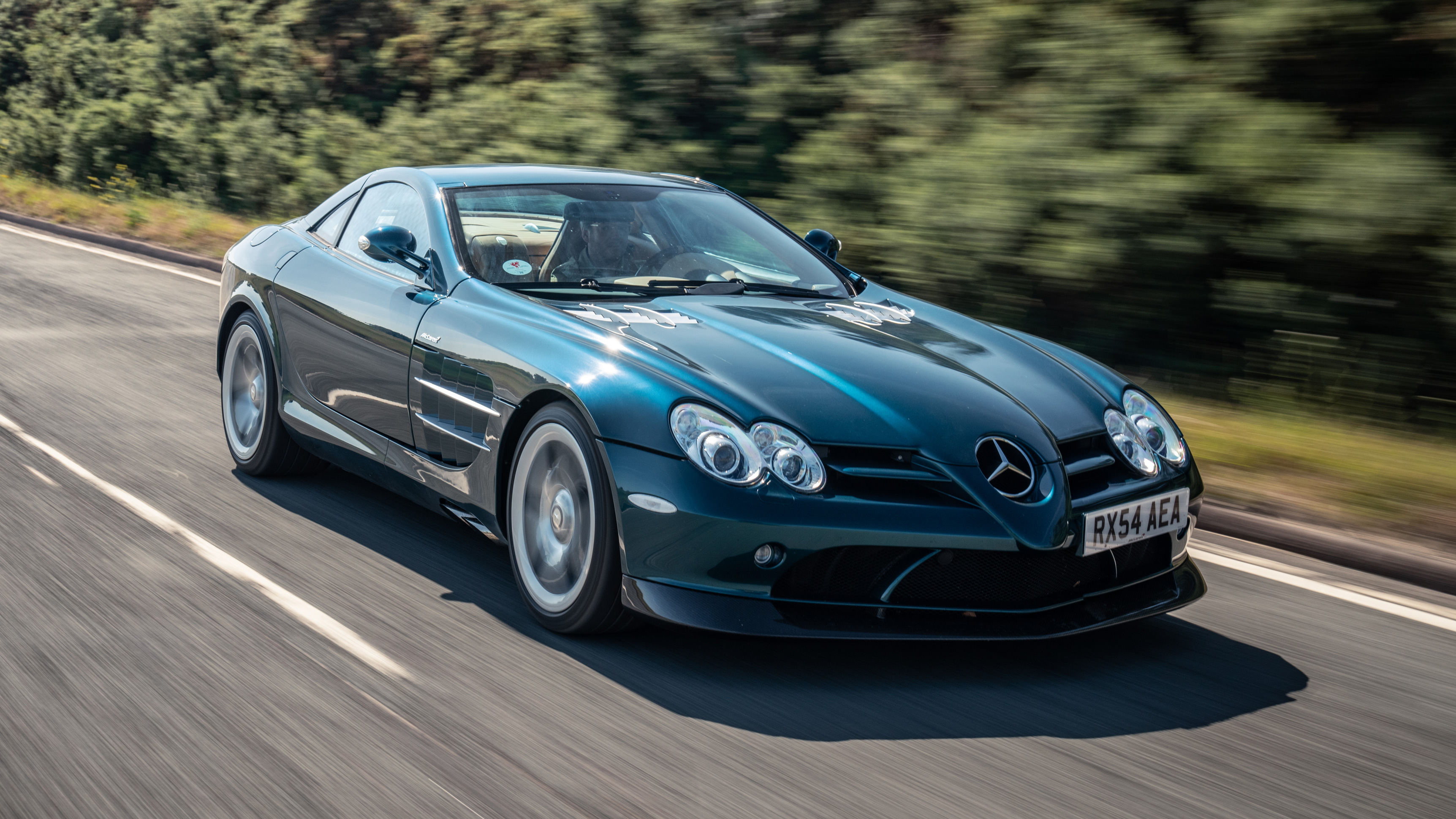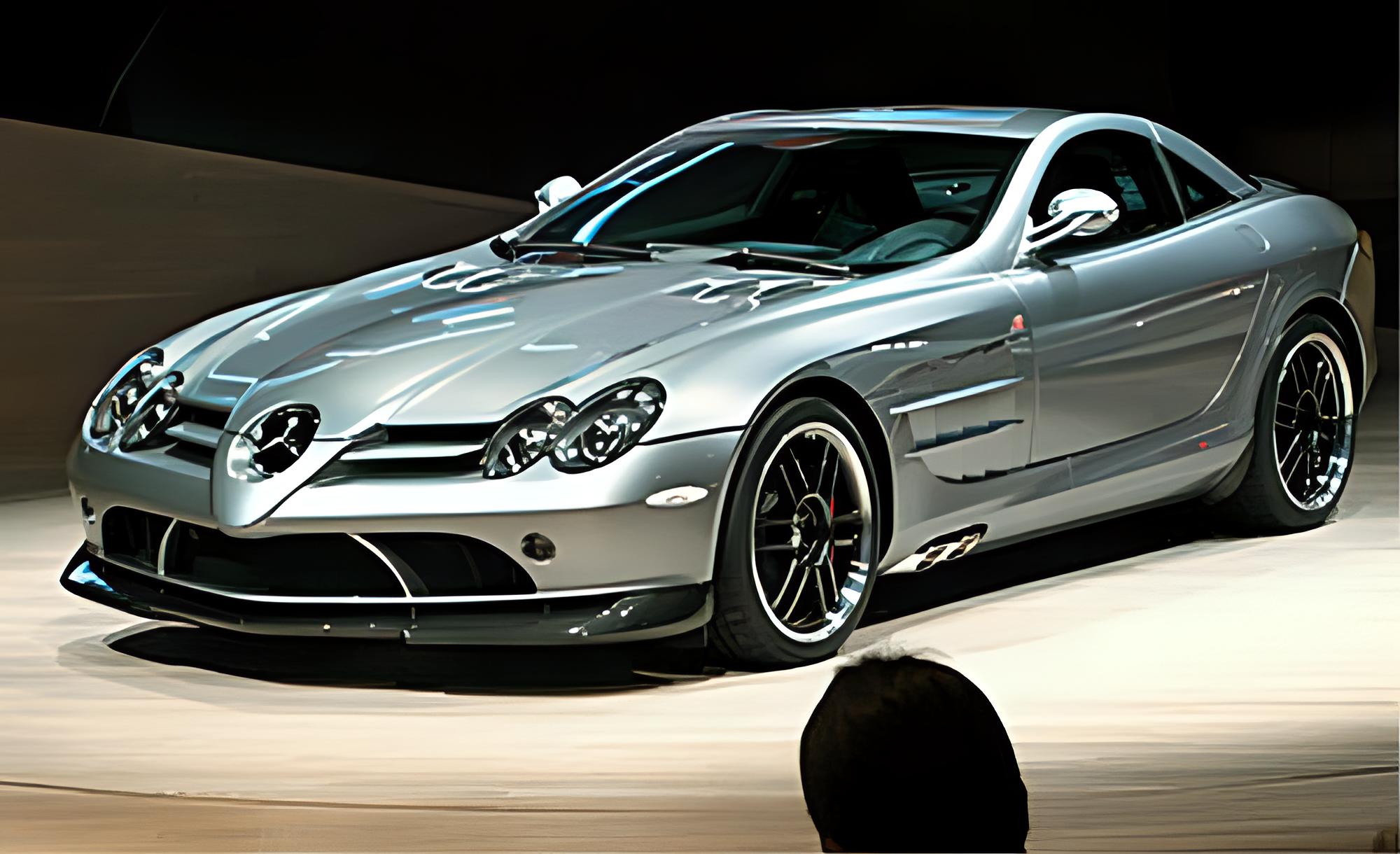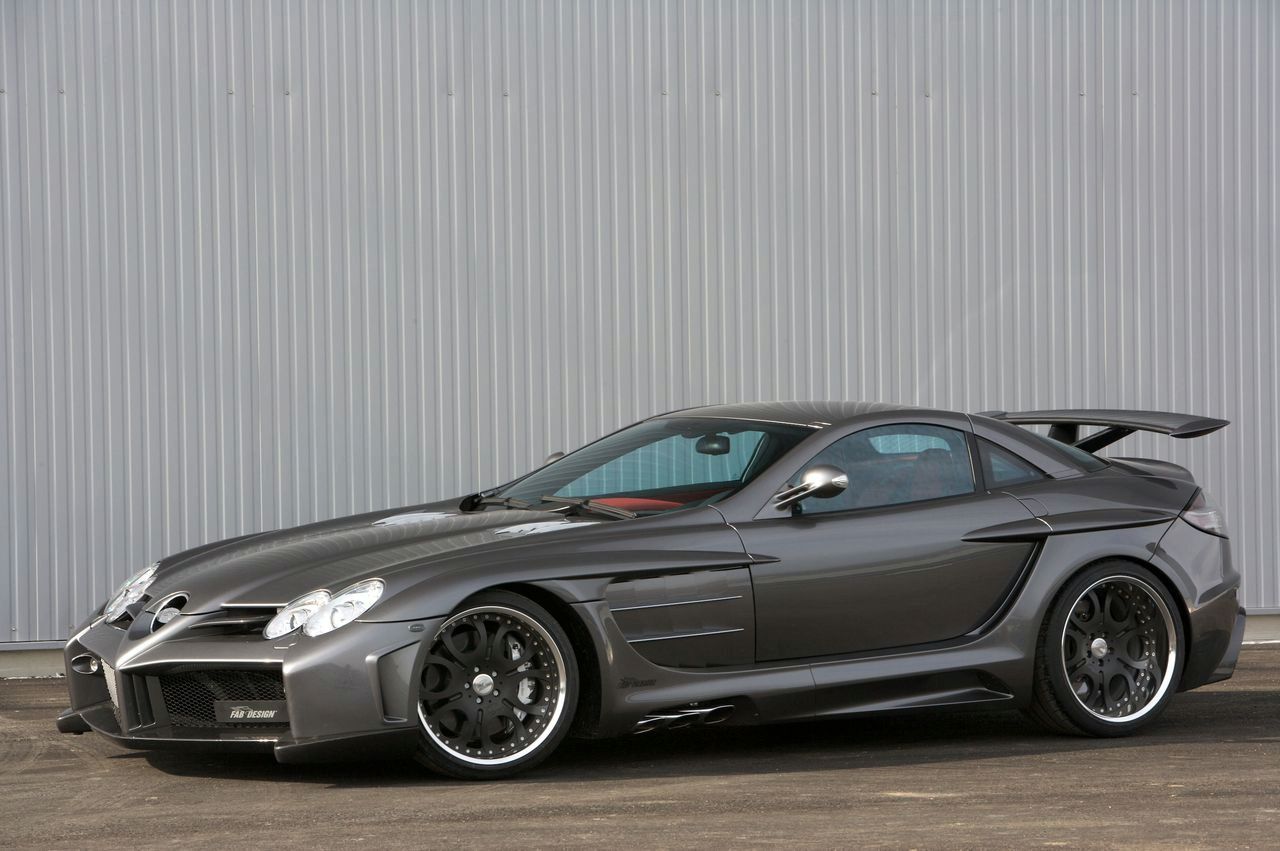The Mercedes-Benz SLR McLaren, a truly remarkable machine, carries a name that hints at its very essence, you know. That "SLR" part isn't just a random set of letters; it actually stands for something quite specific: "Sport Leicht Rennsport." This German phrase, when you break it down, tells a story about what this car was meant to be – a sporty, light, racing machine. It's a designation that really captures the spirit of this high-performance grand tourer, born from a rather unique partnership between two automotive giants.
You see, this particular vehicle was the result of a collaboration that brought together Mercedes-Benz, known for its luxury and engineering precision, with McLaren, a name synonymous with Formula 1 racing and cutting-edge performance. Their combined efforts aimed to create something that blended raw speed with a certain level of refinement, something that could tear up a track but also be driven comfortably on a long journey, in a way. The "SLR" designation, therefore, was more than just an abbreviation; it was a promise of what the car delivered.
This car, which first appeared in the early 2000s, quickly became a symbol of extreme performance and exclusive design, you might say. Its powerful engine, distinctive looks, and the heritage it carried made it an instant icon. Understanding "what does SLR stand for Mercedes" helps us appreciate the thought and ambition that went into creating such a special automobile, a car that, quite frankly, still turns heads and sparks conversations today.
- Elisabeth Chalier
- Liz Cambage Boyfriend
- How Did Juice Wrld Die
- Is Alyssa Diaz Mexican
- Ryan Trahan Haley Wedding
Table of Contents
- The Story Behind the SLR Mercedes
- What Does SLR Stand For Mercedes-Benz's Iconic Supercar?
- A Look at the "Sport" in SLR
- The "Leicht" Element- How Light Was the SLR Mercedes?
- Was the Mercedes SLR Truly a "Rennsport" Machine?
- The McLaren Partnership- A Crucial Part of the SLR Mercedes Story
- How Did the SLR Mercedes Influence Future Cars?
- What Makes the SLR Mercedes Still So Special Today?
The Story Behind the SLR Mercedes
The tale of the Mercedes-Benz SLR McLaren is, in some respects, a fascinating chapter in automotive history. It began with a vision to create a very special kind of car, one that would honor the spirit of the legendary 300 SLR race car from the 1950s, yet bring it firmly into the modern age. This wasn't just another performance car; it was meant to be a grand statement, a machine that blended extreme speed with a certain elegance, a truly unique blend. The decision to team up with McLaren, a British company with a deep well of knowledge in building very fast, very precise machines for the track, seemed like a natural fit for this ambitious goal.
The partnership between Mercedes-Benz and McLaren was, you could say, a meeting of minds, each bringing their particular strengths to the table. Mercedes contributed its extensive experience in crafting luxurious, powerful road cars, along with its long history of engineering excellence. McLaren, on the other hand, brought its expertise in lightweight construction, advanced aerodynamics, and, of course, its unparalleled success in Formula 1 racing. This collaboration was, quite literally, designed to push boundaries, to create a vehicle that was more than the sum of its parts, something quite extraordinary, honestly.
The vision for the SLR was clear: it had to be a car that felt at home on both the open road and, if you dared, a racing circuit. It needed to be incredibly quick, yet also offer a level of comfort and refinement that made it suitable for long-distance travel. The name "Sport Leicht Rennsport" was chosen very carefully to reflect these core principles. "Sport" spoke to its athletic abilities, its quick responses, and its engaging driving feel. "Leicht" pointed to the clever use of materials to keep its weight down, which is essential for performance. And "Rennsport" directly referenced its racing lineage, its connection to competition, and its ability to perform at a very high level, you know.
What Does SLR Stand For Mercedes-Benz's Iconic Supercar?
So, let's get right to it: "SLR" in the Mercedes-Benz SLR McLaren stands for "Sport Leicht Rennsport." This translates directly from German to "Sport Light Racing," and it's a name that, quite frankly, perfectly encapsulates the car's entire character and purpose. The folks behind this project chose these words for very good reasons, reflecting the car's core design principles and its aspirations. It was meant to be a machine that combined the thrill of a sports car with the efficiency of lightweight construction and the spirit of a purebred racer, basically.
The choice of "Sport" was obvious when you consider the car's performance capabilities. It wasn't just fast; it was built to be engaging to drive, with a powerful engine and responsive handling that made every journey feel like an event. The "Leicht" aspect, meaning "light," was a truly significant part of the car's engineering. To achieve this, the designers and engineers used advanced materials, especially carbon fiber, extensively throughout the car's structure. This material, known for its incredible strength-to-weight ratio, helped keep the overall mass down, which is absolutely vital for a car aiming for top-tier performance, as a matter of fact.
And then there's "Rennsport," which means "Racing." This word connected the car directly to Mercedes-Benz's rich racing heritage, particularly the legendary 300 SLR. It also hinted at McLaren's own deep roots in motorsport. While the SLR McLaren was a road car, it possessed many qualities found in racing machines: incredible acceleration, high top speeds, and a design influenced by aerodynamic principles used on the track. It was, in a way, a road-legal race car, bringing a piece of the track experience to everyday driving, or at least to those who could afford such a machine.
A Look at the "Sport" in SLR
When we talk about the "Sport" aspect of the Mercedes-Benz SLR McLaren, we're really talking about its raw, unadulterated performance. This car wasn't just a pretty face; it packed a serious punch under the hood. At its heart was a supercharged 5.4-liter V8 engine, handcrafted by AMG, which produced a truly staggering amount of horsepower. This engine allowed the SLR to accelerate with incredible force, pushing you back into your seat as it surged forward, you know.
The numbers speak for themselves, really. The car could go from a standstill to 60 miles per hour in just a few seconds, and its top speed was well over 200 miles per hour. These figures were, at the time of its release, truly world-class, putting the SLR in the same league as some of the fastest cars on the planet. But "Sport" wasn't just about straight-line speed. It also encompassed the car's handling characteristics, its ability to respond quickly to driver inputs, and the feeling of being connected to the road, which is pretty important for a car like this.
Despite its immense power, the SLR was also designed to be a grand tourer, meaning it could cover long distances with relative ease. This blend of raw sporting ability and long-distance comfort was a key part of its appeal. It wasn't a stripped-down track machine; it had a luxurious interior, comfortable seats, and features that made it usable on public roads. So, while it could certainly perform like a sports car, it also offered a more refined experience, making it a very versatile, if somewhat intimidating, vehicle, basically.
The "Leicht" Element- How Light Was the SLR Mercedes?
The "Leicht" part of the SLR's name, meaning "light," points to one of the most innovative aspects of its construction. To achieve its impressive performance figures, keeping weight down was absolutely essential, and the engineers went to great lengths to make this happen. The most significant way they did this was by building the car around a carbon fiber monocoque chassis. This was a pretty advanced approach for a road car at the time, actually.
A carbon fiber monocoque is essentially a single, incredibly strong, and very light structure that forms the core of the car. It's similar to what you'd find in a Formula 1 car, providing exceptional rigidity and crash protection while weighing significantly less than traditional steel or aluminum structures. This choice of material was a clear indication of McLaren's influence, bringing their motorsport expertise directly into the design of a road-going vehicle. The result was a car that, for its size and power, was surprisingly nimble and responsive, you know.
While specific weight comparisons can be tricky due to different car types and eras, the SLR's use of carbon fiber placed it among the lighter high-performance cars of its time, especially considering its grand tourer aspirations. The benefits of this lightweight construction are numerous: better acceleration, improved braking, and more agile handling. Less weight means the engine has less mass to move, the brakes have less inertia to stop, and the suspension has an easier time controlling the car's movements. It all adds up to a more dynamic and exciting driving experience, which is what "Leicht" really helped deliver, frankly.
Was the Mercedes SLR Truly a "Rennsport" Machine?
The "Rennsport" aspect, meaning "Racing," is perhaps the most intriguing part of the SLR's name, given that it was primarily a road car. However, the connection to racing runs deep, thanks largely to the McLaren partnership. McLaren's entire identity is built on Formula 1 success, and their engineering philosophy is steeped in the demands of the racetrack. This influence is very apparent in the SLR's design and engineering, from its carbon fiber construction to its aerodynamic features, honestly.
While the SLR wasn't a dedicated track car in the same way a purpose-built race machine is, it certainly possessed many qualities that would make it formidable on a circuit. Its immense power, excellent brakes (carbon-ceramic discs were an option), and the stiffness of its chassis meant it could handle high speeds and aggressive cornering with considerable composure. It was, in some respects, a car that could hold its own on a track day, even if its size and weight meant it wasn't as nimble as some smaller, more focused sports cars.
There were also special editions, like the SLR 722 Edition and the Stirling Moss speedster, which pushed the "Rennsport" envelope even further. These versions offered more power, reduced weight, and more aggressive styling, clearly leaning into the car's racing heritage and capabilities. So, while you might not see an SLR McLaren competing in a professional race series, its DNA, its engineering, and its sheer performance certainly made it worthy of the "Rennsport" designation, carrying that spirit of competition right onto the road, you know.
The McLaren Partnership- A Crucial Part of the SLR Mercedes Story
The collaboration between Mercedes-Benz and McLaren was absolutely central to the creation and identity of the SLR. This wasn't just a badge engineering exercise; it was a deep, meaningful partnership where both companies contributed significantly to the car's development and production. Mercedes, at the time, was a part-owner of McLaren's Formula 1 team, which made the idea of a joint road car project a pretty natural extension of their existing relationship, basically.
McLaren's role in this venture was, you could say, instrumental, particularly in the areas of advanced materials and high-performance engineering. The car was actually assembled at the McLaren Technology Centre in Woking, England, which is a testament to their direct involvement in its creation. Their expertise in carbon fiber construction, honed over decades in motorsport, was vital in building the SLR's lightweight and incredibly strong chassis. They also brought their understanding of aerodynamics and high-speed stability to the table, ensuring the car performed safely and effectively at its very high limits, honestly.
For Mercedes-Benz, the partnership allowed them to create a supercar that pushed beyond their usual production car boundaries, combining their luxury and engine prowess with McLaren's pure performance focus. It was a way to make a statement, to show what was possible when two top-tier automotive companies combined their strengths. The result was a car that felt distinct from other Mercedes models, possessing a unique character that blended German power with British racing pedigree. This joint venture really helped shape what the SLR McLaren became, a truly unforgettable machine, you know.
How Did the SLR Mercedes Influence Future Cars?
The Mercedes-Benz SLR McLaren, while a standalone project, certainly left its mark on the automotive world and, in some ways, influenced what came after it. Its bold design, especially the long hood and side-exit exhausts, became instantly recognizable and, you might say, iconic. It showed that a car could be both a high-performance machine and a striking piece of automotive art, something that many manufacturers strive for today. The sheer presence of the SLR was, and still is, undeniable, frankly.
From an engineering standpoint, the SLR's extensive use of carbon fiber for its primary structure was a significant step for a road car produced in relatively higher numbers than typical hypercars. This helped to further popularize the material in high-end automotive applications, paving the way for more widespread use in subsequent performance models from various brands, including Mercedes-AMG's own more extreme vehicles. It demonstrated the real-world benefits of lightweight construction in a powerful grand tourer, influencing how future performance cars would be built, you know.
The SLR also played a part in solidifying Mercedes-Benz's position in the upper echelons of the performance car market. It proved that they could create a truly extreme vehicle that competed with the very best. While Mercedes-AMG now handles much of the high-performance development, the SLR's legacy of combining immense power with advanced engineering and a distinctive presence continues to resonate. It remains a benchmark for what a luxury supercar can be, influencing both design trends and technological choices in the years that followed, as a matter of fact.
What Makes the SLR Mercedes Still So Special Today?
Even years after its production ended, the Mercedes-Benz SLR McLaren holds a very special place in the hearts of car enthusiasts and collectors. There are several reasons why this car continues to captivate. For one, its unique blend of attributes is quite rare. It's not just a brute-force supercar; it offers a level of refinement and grand touring capability that many of its contemporaries simply didn't, you know. This duality makes it a truly interesting machine.
Then there's its distinct appearance. The long, sweeping hood, the prominent three-pointed star, and those unmistakable side-exit exhaust pipes give it a visual identity unlike anything else on the road. It looks fast even when standing still, and its design has, quite frankly, aged remarkably well. The sound it makes, especially with that supercharged V8 engine, is also something truly unforgettable, a deep, guttural roar that announces its presence long before it's seen, basically.
Its limited production numbers also add to its allure. Not many of these cars were made, making them quite exclusive and sought after on the collector's market. This scarcity, combined with its impressive performance, striking design, and the story of its unique Mercedes-McLaren partnership, ensures its enduring appeal. The SLR McLaren isn't just a car; it's a piece of automotive history, a testament to a time when two legendary names came together to create something truly extraordinary, and that's why it remains so special, honestly.
In short, the Mercedes-Benz SLR McLaren, with its "Sport Leicht Rennsport" meaning, brought together immense power, clever lightweight construction, and a clear connection to racing. This car, born from a unique collaboration between Mercedes-Benz and McLaren, stood out for its blend of extreme performance and grand touring comfort. Its use of carbon fiber and its distinctive design elements were forward-thinking, leaving a lasting impression on the world of high-performance automobiles. It remains a cherished and sought-after vehicle, celebrated for its unique character and its place in automotive lore.
Related Resources:
Detail Author:
- Name : Mrs. Linda O'Keefe
- Username : myrtice95
- Email : dstokes@yahoo.com
- Birthdate : 2001-07-02
- Address : 671 Torrance Plaza Port Vellabury, LA 79993-9342
- Phone : +12249721417
- Company : Rogahn, Swaniawski and Feil
- Job : Aviation Inspector
- Bio : Libero accusamus quaerat quo vel pariatur. Quos est nostrum et in sint. Quam autem aliquid dolor quis numquam omnis vero.
Socials
linkedin:
- url : https://linkedin.com/in/gilbertgusikowski
- username : gilbertgusikowski
- bio : Delectus molestias velit commodi odio.
- followers : 6856
- following : 2155
tiktok:
- url : https://tiktok.com/@gilbert_gusikowski
- username : gilbert_gusikowski
- bio : Consectetur aspernatur et voluptatum et voluptas.
- followers : 5208
- following : 2120
facebook:
- url : https://facebook.com/ggusikowski
- username : ggusikowski
- bio : Quidem dolor facere et quaerat id modi. Unde at soluta id iste.
- followers : 4075
- following : 1335
instagram:
- url : https://instagram.com/ggusikowski
- username : ggusikowski
- bio : Nisi autem nulla vitae dolorem. Pariatur qui voluptatem et. Nostrum aliquam eius in debitis.
- followers : 768
- following : 1180
twitter:
- url : https://twitter.com/gilbert_real
- username : gilbert_real
- bio : Magnam ullam eveniet excepturi eos cum est odio. Aut possimus autem porro doloremque atque facere. Est est et dolorem perspiciatis perferendis.
- followers : 3031
- following : 1829


